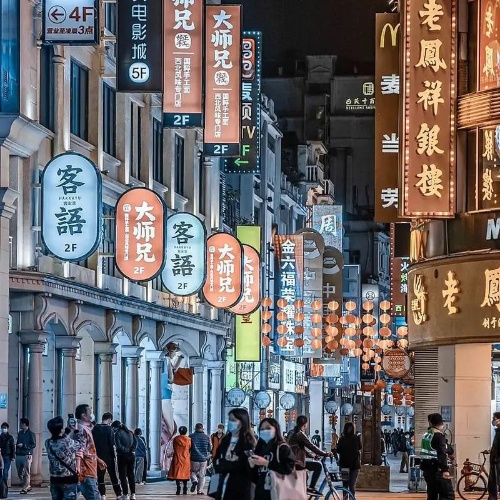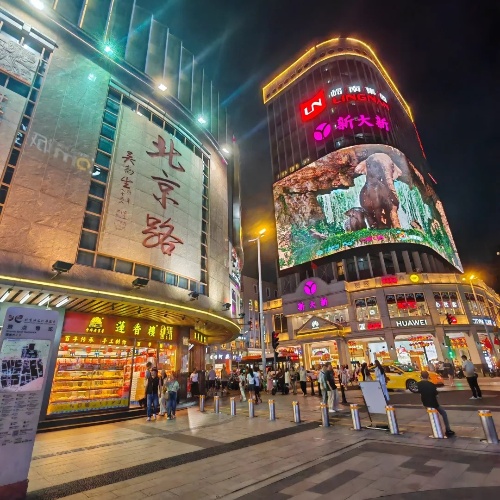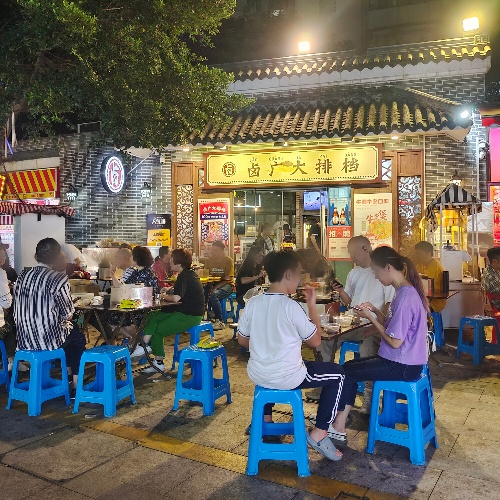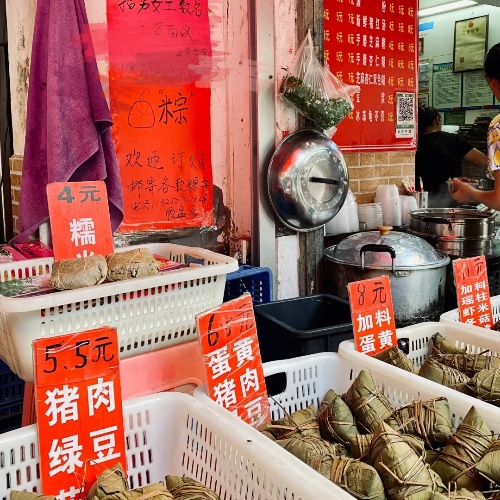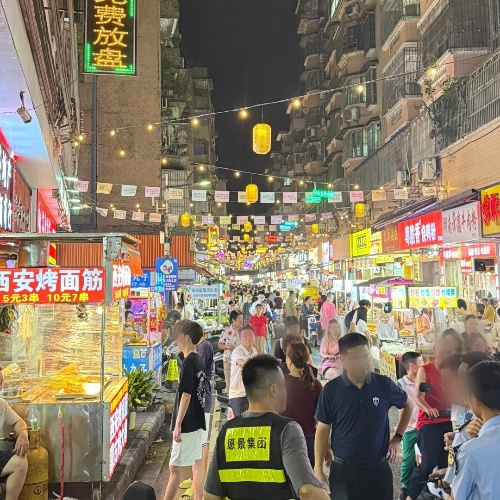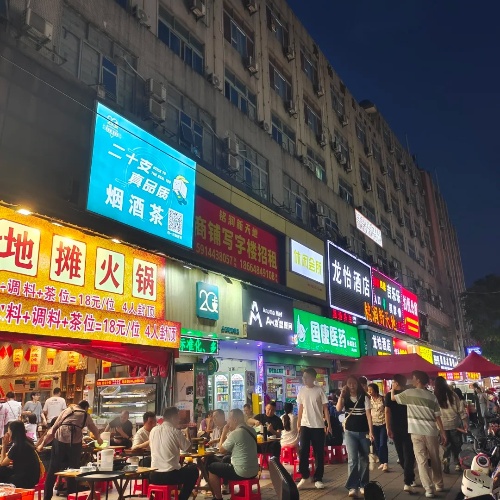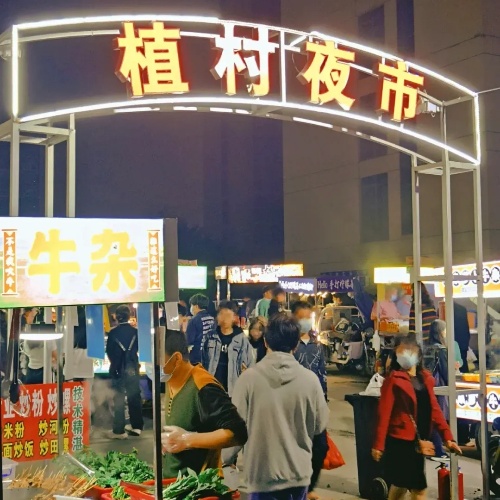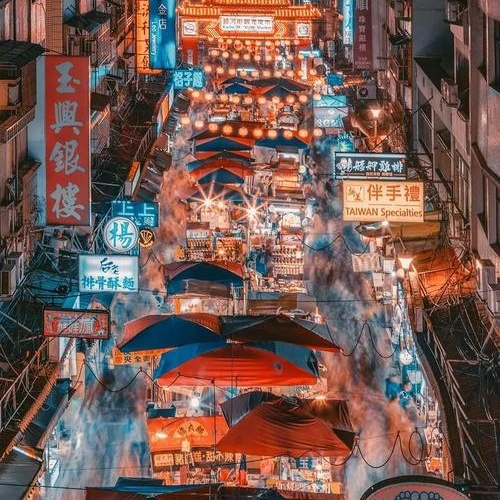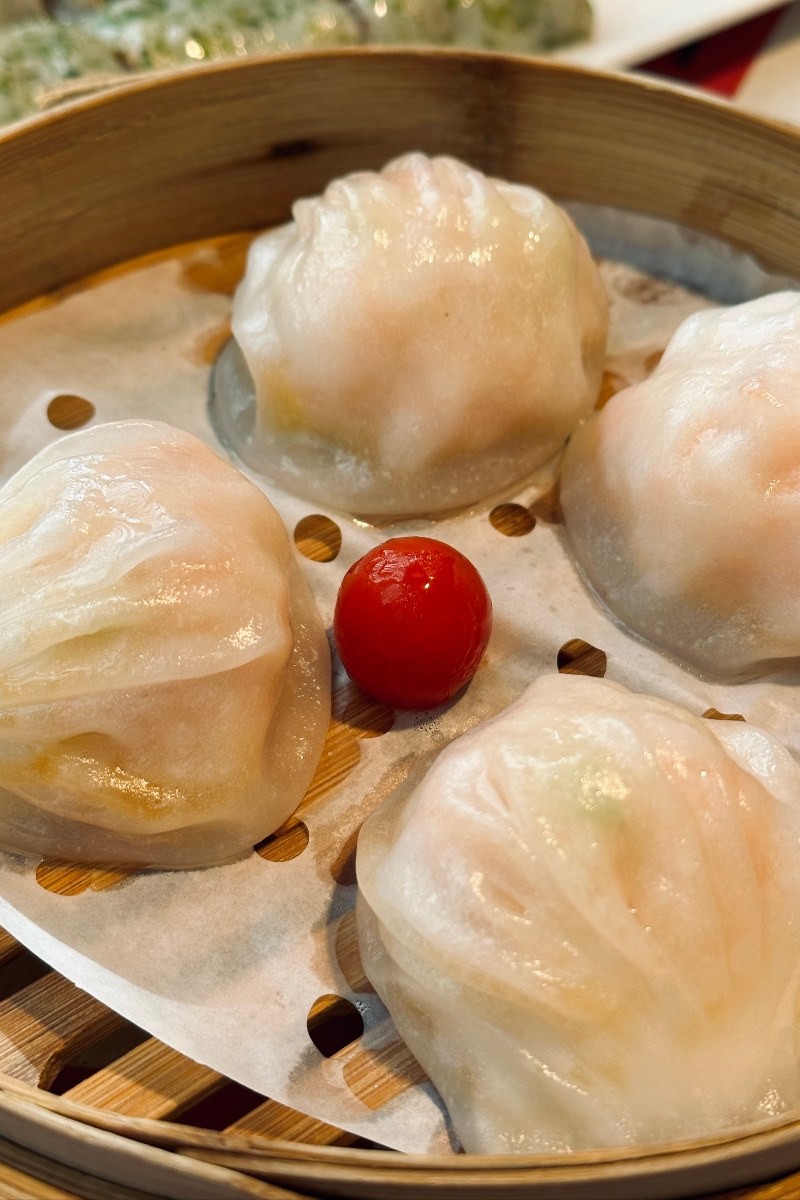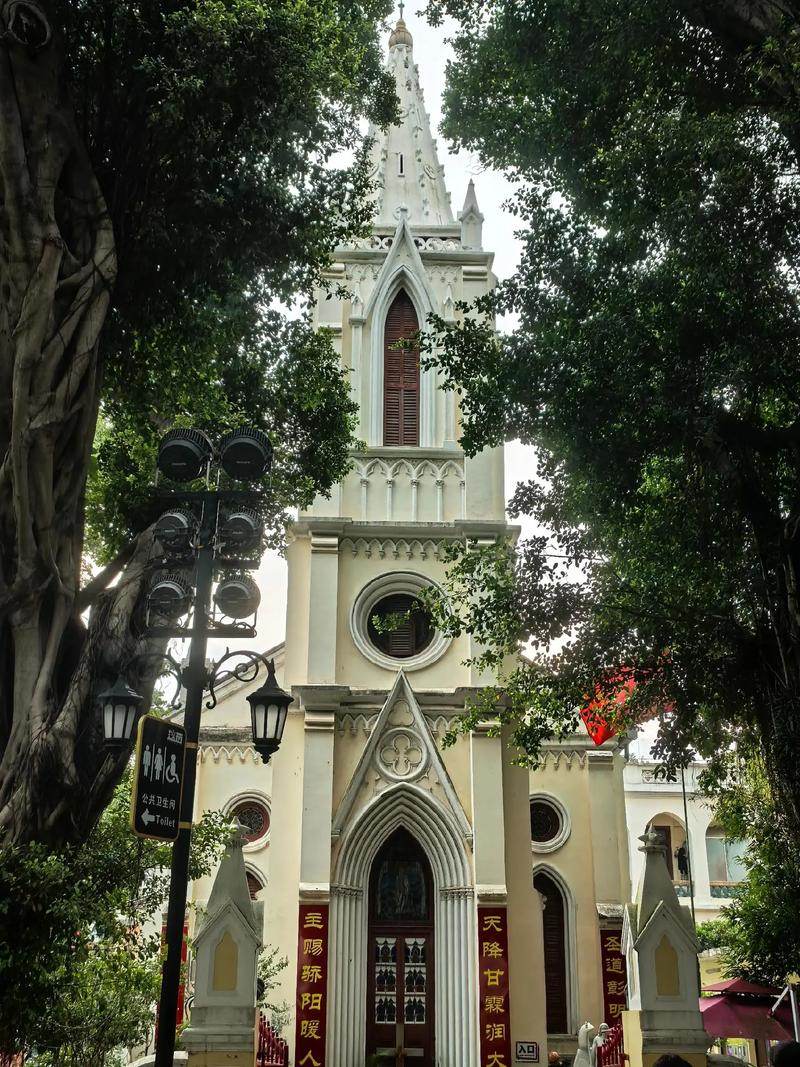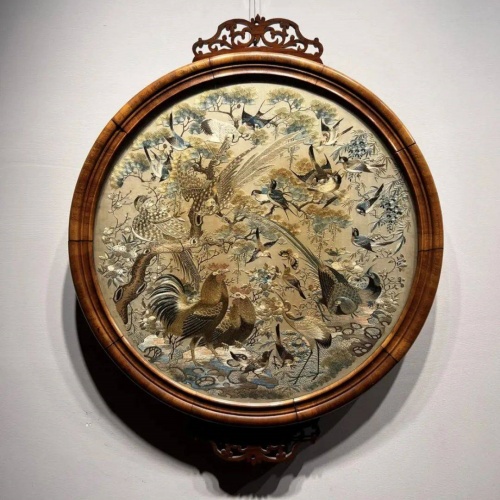Long ago, a great dragon lived along the Pearl River, its scales shining under the moonlight as it watched over the city. The villagers believed that if they gathered after sunset to share food and laughter, the dragon would bless Guangzhou with prosperity. Though the dragon's tale faded into legend, the spirit of nightly gatherings never died. Today, night market in guangzhou carries on that ancient tradition. These bustling markets are more than just places to eat; they are living stages where the city's energy comes alive. Neon lights flicker, skewers sizzle, kids chase bubbles, and families bargain over trinkets with a joy passed down through generations. The night market is no longer just a food court—it's the city’s vibrant cultural heartbeat.
Experience the Historical Charm of the Old City
- Shangxiajiu Pedestrian Street Night Market
- Beijing Road Night Market
- Xiguan Area Night Stalls
Shangxiajiu Pedestrian Street Night Market
Combining the flavour of another era witha bustling present, this unique market is one to remember and has quickly become a favorite for tourists and locals alike! They serve crispy squid skewered with chili salt, as well as honey-roasted chicken wings . Visitors are also urged not to miss: “The crispy squid skewers dusted with chili salt or feast on the honey roasted chicken wings from the Lao Xiang Ji stall — both of which are recommended as a must-try.” Shops selling jade pendants, silk cheongsams and embroidered shoes give travelers an opportunity to purchase traditional souvenirs that tell a story of Guangzhou’s culture.
Beyond stealing a purchase here or there, even the sounds — from vendors’ calls to the rhythm of chatter — are the pulse of a night that’s rich with flavor and history. A stroll here is a testament that Shangxiajiu is also one of Guangzhou china’s most iconic night markets. If you can get inside, the energy can be intimidating, but it’s also exciting. The arcades are illuminated by neon lights, there are also street performers juggling fire, music hovers above the crowd. As tourists congregate under the iconic “Shangxiajiu” sign for photos, photographers chase reflections bouncing off of tiles. It feels like each turn is bustling with action, and part of the fun is finding those busy moments.
📍 Location: Liwan District, Shangxiajiu Pedestrian Street
🕒 Hours: 5 PM – midnight
💰 Average cost: ¥40–60 per person
🚇 Transport: Metro Line 1, Changshou Road Station
💡 Tip: Visit before 7 PM to avoid the heaviest crowds.
Beijing Road Night Market
Standing out for its fusion of history and nightlife, this market lets you literally walk on preserved Song Dynasty roads sealed under glass while neon signs blaze above. Food lovers flock here for rice noodle rolls from Chen Ji Cheung Fun and almond tofu pudding at Tong Yi Dessert House. Painted fans and calligraphy sets are common purchases, giving travelers light, portable reminders of their time in Guangzhou. With a mix of trendy shops and centuries-old roots, it embodies the city’s dual character in one stroll. For many tourists, Beijing Road is the easiest night market in Guangzhou China to explore on their first visit.
As darkness falls, giant red lanterns glow overhead and LED storefronts bathe the street in light, turning it into a carnival of sound and motion. Photographers set up on the glass road for unique shots, and lantern-lined corners make for atmospheric portraits. The constant flow of visitors, the chatter, and the variety of music create a non-stop buzz that feels like Guangzhou distilled into one street.
📍 Location: Yuexiu District, Beijing Road
🕒 Hours: 5 PM – midnight
💰 Average cost: ¥30–50 per person
🚇 Transport: Metro Line 6, Beijing Road Station
💡 Tip: Come after 7 PM for peak atmosphere but expect crowds.
If shopping is on your Guangzhou itinerary, you’ll need Guangzhou 2025: Your Guide to 4 Must-Buy Shopping Categories
Xiguan Area Night Stalls
Authenticity is the reason many travelers head to Xiguan, where the lantern-lit alleys still feel untouched by mass tourism. The claypot beef offal at Ah Ming Niu Za is a signature dish locals praise, while Mei Xin’s mung bean cakes provide a sweet balance. Beyond food, antique-style porcelain, small carved trinkets, and tea sets line the stalls, offering unique finds that echo the city’s historic roots. Strolling here feels less like shopping and more like stepping into a living piece of Guangzhou’s heritage. Visitors often say that Xiguan offers the most authentic night market in Guangzhou China.
The energy is gentler than the city’s larger markets, but the cultural weight is heavy. Photographers favor the carved balconies of old Xiguan mansions glowing in lantern light, while families relax over tea at nearby stalls. It’s a slower, calmer snapshot of the city that rewards visitors with a quieter, more authentic experience.
📍 Location: Liwan District, Xiguan Area
🕒 Hours: 5 PM – 1 AM
💰 Average cost: ¥30–40 per person
🚇 Transport: Metro Line 1, Chen Clan Academy Station
💡 Tip: Carry some cash; QR codes are not always available.
Integrate into the Authentic Local Vibe
- Xiaogang Night Market
- Tonghe Night Market
- Yongtai Night Market
Xiaogang Night Market
Xiaogang stands out because it feels like stepping into the city’s daily life. Here, oyster grills at Uncle Wei’s stall send smoke curling through the air, while Ah Q’s Seafood fries up squid that locals swear by. Shoppers hunt for cheap socks, phone cases, and electronics, with bargaining not just allowed but expected. The balance of food and inexpensive goods makes it a popular neighborhood stop where visitors can blend in with locals. Many say Xiaogang shows the true side of a community night market in Guangzhou China.
The atmosphere is raw but full of spirit. Bare bulbs cast a yellow glow over steam rising from food stalls, families wander with plastic bags of skewers, and teenagers lean on scooters chatting between bites. For photographers, the most striking shots come from capturing these unfiltered moments: smoke-filled air backlit by streetlights or candid smiles of locals savoring midnight snacks.
📍 Location: Haizhu District, Xiaogang Road
🕒 Hours: 6 PM – midnight
💰 Average cost: ¥20–30 per person
🚇 Transport: Metro Line 8, Shayuan Station
💡 Tip: Best for bargain shopping and late-night bites.
Tonghe Night Market
Tonghe thrives on variety, offering sugarcane juice pressed on the spot and fiery skewers at Lao Zhou’s BBQ. Household goods and casual clothes are also common, drawing local families who see it as both a shopping trip and a chance to eat out together. The mix of street snacks and practical items makes it versatile and approachable for newcomers. Travelers often find Tonghe the most balanced night market in Guangzhou China.
Its mood is relaxed compared to the louder downtown markets. Children chase each other around plastic tables, parents sip sweet soup, and couples share skewers under soft streetlights. Photographers will find charm in the simple details: colorful murals, walls painted with folk art, and the glowing faces of vendors under neon signs.
📍 Location: Baiyun District, Tonghe Street
🕒 Hours: 5 PM – midnight
💰 Average cost: ¥25–40 per person
🚇 Transport: Metro Line 3, Tonghe Station
💡 Tip: Bring coins or small bills for easier payments.
Yongtai Night Market
Yongtai draws night owls with its famously late hours, where food stalls stay open well past midnight. Lao Huang’s Skewer Shop dishes up spicy grilled intestines, while Sweet House tempts passersby with bowls of mango pudding. In addition to snacks, shoppers can find cheap slippers, bags, and other everyday goods that make it practical as well as indulgent. Yongtai is the night market in Guangzhou China that never seems to sleep.
The atmosphere here is vibrant and enduring, with neon buzzing late into the night and the smoky aroma of charcoal grills filling the air. Long lines at dessert stalls and lantern-lit corners make for memorable photo opportunities, especially for those who want to capture Guangzhou’s nightlife at its most unfiltered.
📍 Location: Baiyun District, Yongtai New Road
🕒 Hours: 6 PM – 2 AM
💰 Average cost: ¥25–35 per person
🚇 Transport: Metro Line 3, Yongtai Station, Exit B2
💡 Tip: Go late if you want to see how locals truly eat.
Embark on a Late-Night Culinary Journey
- Zhicun Night Market
- Jiangnan West Night Market
Zhicun Night Market
Known as Guangzhou’s midnight stomach, Zhicun buzzes with the smoke of grills and the chatter of students. Visitors line up for the stinky tofu at Lao Biao Stinky Tofu, while milk tea lovers head to Coco Fresh, open late into the night. Cheap phone cases and anime accessories are staples, giving the market a youthful flair. The mix of savory snacks and quirky goods makes it a favorite for young crowds seeking both taste and fun. For anyone craving student vibes, Zhicun is the most popular night market in Guangzhou China.
The mood is chaotic but addictive, full of neon lights glowing above narrow stalls and the crackle of skewers cooking on open fire. Students laugh with skewers in hand, making the perfect backdrop for candid shots. Photographers find dramatic scenes in the haze of smoke drifting across colorful shop signs. Standing at the busy crossroads of Zhicun 2nd Road, you’ll see a panorama of Guangzhou nightlife in motion.
📍 Location: Panyu District, Zhicun 2nd Road Cross
🕒 Hours: 5 PM – 2 AM
💰 Average cost: ¥30–50 per person
🚇 Transport: Metro Line 5, Yuancun Station, Exit C
💡 Tip: Arrive after 7 PM to dodge the rush.
Jiangnan West Night Market
The appeal of Jiangnan West lies in its family feel, with tables spilling into the streets and kids slurping congee beside parents. You’ll want to try Ham Sui Gok at Wong’s Dumpling Stall, and sip herbal jelly from Lao Gan Dessert House. Vendors here also sell simple toys and trinkets—cheap, cheerful items kids beg for. It’s one of the most family-friendly options for a night market in Guangzhou China.
The street glows with warm lanterns and the hum of chatter. Street murals and graffiti walls are popular photo spots, giving Jiangnan West a mix of cultural flair and neighborhood intimacy.
📍 Location: Panyu District, Jiangnan West Road
🕒 Hours: 5 PM – midnight
💰 Average cost: ¥25–40 per person
🚇 Transport: Metro Line 2, Jiangnan West Station
💡 Tip: Best after 8 PM when the street vibe peaks.
Follow the Pulse of Youth Culture
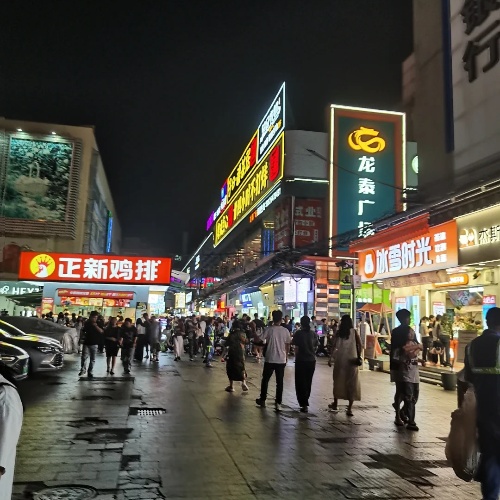
Longdong Night Market
Tangxia Smart Market
Tangxia Smart Market is a newer addition to Guangzhou’s night scene, combining food stalls with modern digital payment and smart retail systems. Visitors often head straight to popular stalls offering spicy grilled skewers, bubble tea shops that serve oversized cups, and dessert stands selling mango sago pudding. Souvenir stalls sell creative trinkets, accessories, and tech-inspired gadgets, giving the market a fresh and trendy feel that appeals to younger crowds. It’s a blend of tradition and innovation, marking Tangxia as a unique night market in Guangzhou China.
The market atmosphere is lively but more organized than older ones. Bright LED screens highlight promotions, while neon signs and smart kiosks light up groups of friends snapping selfies. Photographers often capture the contrast of traditional street food with modern smart retail backdrops.
📍 Location: Tianhe District, Tangxia
🕒 Hours: 6 PM – midnight
💰 Average cost: ¥20–35 per person
🚇 Transport: Metro Line 21, Tangxia Station
💡 Tip: Visit with friends to enjoy both the food and the tech-forward vibe.
Longdong Night Market
Longdong appeals to those who want a taste of China’s regional diversity without leaving Guangzhou. Alimu’s Grill serves Xinjiang lamb skewers that drip with spice, while Han Dong Stall cools things down with Northeastern-style cold noodles. Stalls also sell trendy caps and budget phone gadgets, perfect for students mixing style and practicality.
The atmosphere is tighter and more compact than other university markets, with narrow lanes glowing under LED lights. The sparks from BBQ grills add a touch of drama to photographs, and the concentrated energy of students snapping photos makes it a social media hotspot.
📍 Location: Tianhe District, Longdong Street
🕒 Hours: 5 PM – midnight
💰 Average cost: ¥20–30 per person
🚇 Transport: Metro Line 6, Botanical Garden Station
💡 Tip: Perfect for trying regional foods in small portions.
Uncover the City's Creativity and Surprises
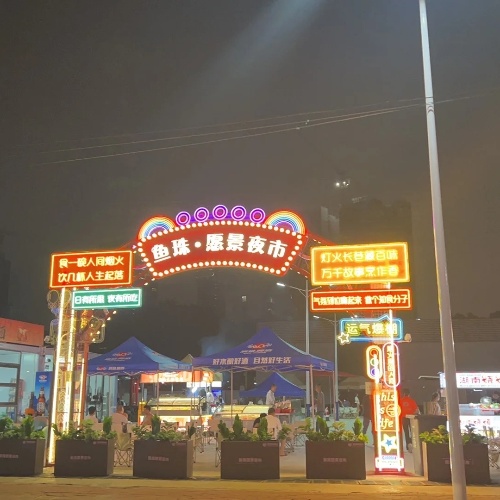
Yuzhu Night Market
Yuzhu Night Market
Creativity is the soul of this market, with its mix of handmade jewelry, quirky crafts, and live sketch artists pulling in curious visitors. Chen’s Seafood is a must-stop for grilled oysters, while Colorful Cups serves rainbow-hued fruit teas that taste as vibrant as they look. Canvas bags and hand-painted postcards make easy souvenirs, offering travelers concrete targets when exploring the stalls.
Fairy lights string across alleys, giving the place a casual but artistic mood. It feels relaxed yet buzzing, and photographers love the artisan corners where glowing stalls look like living postcards. Bright murals and softly lit stalls create photo backdrops that visitors can’t resist, making Yuzhu one of the most photogenic night market in Guangzhou China.
📍 Location: Huangpu District, Yuzhu
🕒 Hours: 5 PM – 11 PM
💰 Average cost: ¥40–60 per person
🚇 Transport: Metro Line 5, Yuzhu Station
💡 Tip: Ideal for evening strolls and creative shopping.
Lilang Market (Xilang)
Here practicality and food culture meet, with Lao Wu’s Sweet Shop famous for syrup-soaked tofu pudding and Guang Ji Congee serving steaming bowls of fish porridge. Locals stock up on vegetables, dried goods, and snacks, making it as much a community grocery as a food stop. Travelers will find it rewarding to taste desserts while browsing fresh produce, knowing exactly what locals buy each day.
The atmosphere blends the feel of a produce bazaar with that of a cozy food court. By day, vibrant stalls of vegetables and fruit catch the eye, while at night steaming desserts draw in crowds under neon light. Photographers enjoy switching between these contrasting scenes, and many say this dual identity makes Lilang a truly unique night market in Guangzhou China.
📍 Location: Liwan District, Xilang
🕒 Hours: 9 AM – 10 PM
💰 Average cost: ¥30–40 per person
🚇 Transport: Metro Line 1, Xilang Station
💡 Tip: Go earlier if you want fresh produce; later for snacks.
Practical Tips: Master the Night Market Experience
Getting There & Timing
In Guangzhou, most night markets begin to operate at around 5–6 PM and remain in full operation and their most crowded time is from 7 to 10 PM. Early evenings work for families or out-of-town guests looking for room to move, while latter hours carry denser crowds, longer lines and powerful food smells. The Guangzhou Metro is the best way and many of the exits are near famous markets. You will likely have to walk through side alleys to get to smaller community stalls. Driving is not recommended due to limited parking and traffic congestion. You can take a taxi or ride-hailing service back late at night after the metro closes.
Payment & Safety
Alipay and WeChat Pay are used everywhere, from small snack stalls on the street. Water bottles: These can be purchased for cash, which is useful for some of the older vendors, though they may not have much change. Credit cards from abroad are generally not accepted. Have your mobile payment ready before you arrive. It’s safe overall, but crowded lanes can make pickpocketing easy, so ensure your belongings are safeguarded. Pick crowded stalls so you can be sure of food turnover and freshness. Don’t eat raw seafood in the middle of a hot summer, and choose cooked or boiled. Bring wet wipes or hand sanitizer for a fast clean after eating on the street.
Language & Interaction
English isn’t the common tongue, but with a little pointing or ordering by gesture, food comes to the table. Vendors are well-acclimated to tourists and typically flash picture menus or assist with a few pleading words. It does help to know some basic Cantonese words; “Nei go” (this one) and “Hou sik” (delicious) will get you pretty far both in terms of ordering and friendliness. Even in big markets such as Beijing Road, both signs in Chinese and English are available, and in local markets, signs are built to be read visually, not verbalized. Apps for translation come in handy for haggling over goods. Vendors are usually kind and a friendly smile can make it easier to do business.
FAQs: Your Answers to Common Night Market Queries
Q: When do Guangzhou night markets open and close?
A: Most night markets in Guangzhou start getting ready around 5 p.m., and the peak hours are generally 7 to 10 p.m., when families, students and office workers pack in. Neighbourhood markets often remain open later, some past midnight, lending a lazy feel where locals sit with bowls of congee or late-night skewers. But if you aim for after 11 p.m., you may encounter fewer tourists and more uncut slices of daily life. Not all of the stalls will be as accommodating (some pack up when they sell out of product), but generally the game plan is to arrive just after dinner and stick around until the streets empty out.
Q: Can I pay using a non-chinese credit card, do I need WeChat/Alipay?
A: Foreign cards are seldom accepted at Guangzhou’s night markets, where the majority of vendors use QR code systems. WeChat Pay and Alipay are the norm, even for inexpensive snacks that cost only a few yuan. Bring some cash in smaller bills as a backup, since a few older or smaller-level vendors still accept only it. For tourists, topping up Alipay or using a foreign bank card that is tied to the app are often the easiest. And don’t expect to be able to swipe a Visa at a street stall — you’ll save yourself time and headache if you get your mobile payments ducks in a row in advance.
Q: Is there a night market more geared toward first-time visitors than others?
A: Beijing Road is the mostly foreign-friendly for its convenient location and bilingual signs. While a large district may not feel as chaotic as a nearby micro-market, the latter is usually manned and that is good for first-time customers. It also has the popularity, however, so it comes with tourist prices and more people. For a more middle-of-the-road choice, Zhicun Night Market is fairly no-frills and you can enjoy a decent range of budget-friendly food and a Good-for-Foreigners crowd of younger locals. If you are nervous about getting lost or overcharged, Beijing Road is still the safest option for a first foray.
Q: Is it safe to visit the night markets in Guangzhou on your own?
A: Generally, yes, solo travelers often say they have felt safe in night markets in Guangzhou. The streets are well-lit, filled with families and patrolled in the busiest sections. That said, the same old rules apply in any city: Keep wallets and phones secure, don’t flash valuables and, if chatting with strangers, keep drinks or open foods in sight. Late-night visits can be more isolating at the less-populated community markets, so go to the bigger ones if you’re on your own. The atmosphere is generally welcoming, and locals are liable to smile or chat with you if you express interest in their food.
Q: Are there vegetarian or halal options?
A: Yes, but you’ll have to keep them peeled. Halal-friendly snacks Have I mentioned tartrate tart? Well, it's one of the halal snacks on Huifu Road (near Huaisheng Mosque) -- or halal tofu mixed with rose, or sesame biscuit, or what Buddhists and Muslims seem to agree can have the first bite of a new moon cake made by Hui and Uyghur families. There are also plenty of vegetarian options — steamed rice rolls, sweet soups like the one with red bean paste and lots of fruit-based desserts. The difficulty is cross-contamination; so many grills cook meat and vegetables in parallel. If you’re strict, search out stalls that are obviously advertising vegetarian or halal, or find more wallet-friendly prices at university-area markets where dietary variety is greater.
Q: How to even speak if vendors do not speak English?
A: Pointing actually works pretty well and a lot of vendors who do not speak English are good sports about miming. A smile and a quick “Nei go” (Cantonese for “this one”) can take you a long way. Some stalls near popular tourist zones may have photo menus or rudimentary English descriptions, but don’t expect that everywhere. It’ll aid you in bargaining for goods, and being able to say a few written phrases. Vendors typically get a kick out of the effort, and a little bit of humor can work wonders in bridging the gap between languages.
Q: Is bargaining expected?
A: “If you’re buying something, like a garment, a souvenir, an accessory, whatever it is, haggling is part of their culture — start low, smile, and meet in the middle.” For food, though, prices are steady and typically prominently posted. You don’t want to over-negotiate with food vendors, it’s seemingly impolite, but enquiring politely if there’s a combo deal is all good. Prices at community markets are already crazy low; consider haggling more about making a connection than breaking the bank. As a rule of thumb, tourists who meet it with friendliness and respect will walk away with a fair price, or perhaps conveyance the vendor slipping in an extra snack or two as a sign of goodwill.
